California, a western U.S. state, stretches from the Mexican border along the Pacific for nearly 900 miles. Its terrain includes cliff-lined beaches, redwood forest, the Sierra Nevada Mountains, Central Valley farmland and the Mojave Desert. Common California trees include:
- Valley Oak (Quercus lobata)
- California Sycamore (Platanus racemosa)
- California Black Walnut (juglans hindsii)
- Fremont Cottonwood (Populus fremontii)
- Oregon Ash (fraxinus latifolia)
- Box Elder (acer negundo)
- Gray Pine (pinus sabiniana)
- California White Alder (alnus rhombifolia)
- California Buckeye (Aesculus californica)
- Willow (Salix)
- Coast Redwood (sequoia sempervirens)
- Santa Lucia Fir (abies bracteata)
- Vine Maple (acer circinatum)
- River Birch (betula nigra)
- Hackberry (Celtis reticulata)
- Sargent Cypress (Cupressus sargentii)
- Giant Sequoia (Sequoiadendron giganteum)
- California Nutmeg (Torreya californica)
- California Fan Palm (Washington filifera)
- Joshua Tree (yucca brevifolia)
- Western Redbud (Cercis occidentalis)
- Carolina Holly (ilex ambigua)
Valley Oak

Valley oak (Quercus lobata), native to central and interior valleys of California. These trees can reach a height greater than 100 feet at maturity and the bark may be as thick as 5 or 6 inches in some places.
This tree is the largest oak in North America and is loved for its majestic, arching canopy and picturesquely twisted branching patterns. This tree provides essential habitat for local wildlife and its acorns are an important food source for squirrels and birds.
California sycamore

California sycamores are usually somewhat smaller; typical trees are 30 to 60 feet tall with trunks 3 feet across. In premium soil, however, California sycamores can be colossal in their own right, reaching at least 116 feet in height and with trunks 8 or 10 feet in diameter.
All sycamores work well in large, natural areas; because they have dense growth habits, they make excellent shade trees. California sycamore has a favorable fire resistance rating and can tolerate high heat and wind.
Their massive size results in a high level of seed cluster, leaf, twig and bark debris, and their roots can buckle sidewalks and driveways once the trees reach maturity.
Also Read: Common Florida Flowers
California black walnut

The California black walnut, also called the California walnut, or the Southern California black walnut, is a large shrub or small tree of the walnut family endemic to Southern California. It can be easily identified by its compound leaves, which are rare in our native trees, and the small walnuts it produces in spring
California black walnut can be either a large shrub with 1–5 trunks, or a small, single-trunked tree. The main trunk can fork close to the ground, making it look like two trees that have grown together, then diverged. It has thick bark, deeply channeled or furrowed at maturity.
Fremont cottonwood

The Fremont cottonwood is a tree that grows in riparian areas near streams, rivers, and wetlands in California. It has a broad, open crown and stout, widely spread branches. When the tree is young, the bark, branches, and twigs are smooth. As the tree ages, the bark becomes deeply furrowed with cracks. Its leaves are shiny, triangular to heart-shaped, and light green with white veins.
The Fremont cottonwood can grow to about 70 to 90 feet (21 to 27 meters) in height with a diameter of two to three feet. It is one of the most important plant species to western wildlife. The trees are also important for stabilizing stream banks, producing debris that provides habitat for fish, and providing erosion control and shade.
Oregon Ash
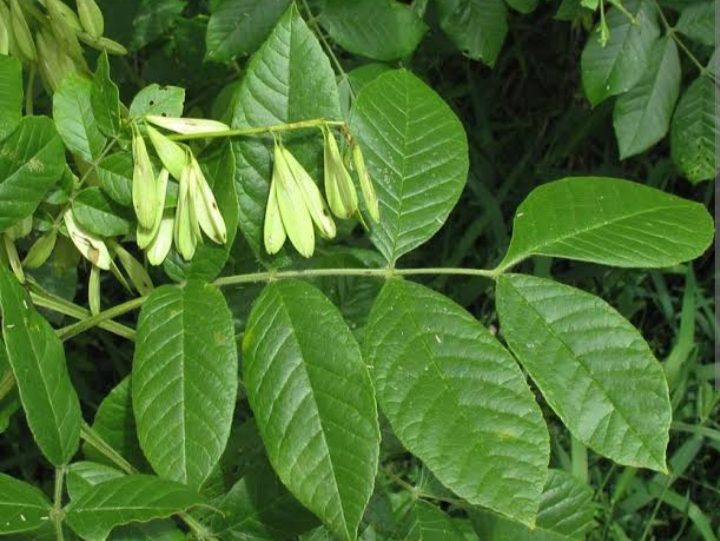
Native to the Pacific Northwest Oregon ash is a medium to large tree characterized by branches that thrust outward almost parallel to the ground. When growing in the open, Oregon Ash develops a broadly shaped crown similar to that of maple trees.
This tree grows 65-80 feet and can be very long-lived, up to 250 years. It grows fast as a young tree but slows down with maturity. It is found growing along waterways, bottomlands and other damp to wet sites. It prefers climates with cool and humid summers and winters that are usually mild.
Boxelder
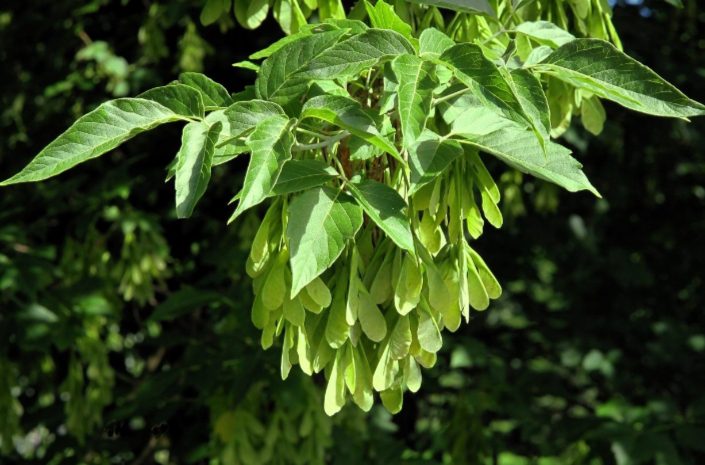
Boxelder is a native, fast-growing maple tree, found throughout Florida, Minnesota to California. Box elder, also known as the ash-leaved maple, maple ash, or Manitoba maple, is a medium-sized (35-70 feet tall), deciduous tree with an average lifespan between sixty and seventy-five years, but are capable of reaching up to one hundred years under optimal conditions.
When given ample room to grow, box elders take on an irregular shape with their trunk quickly splitting into multiple, widespread branches. When grown in close proximity to other trees, branches do not grow as drastically in a lateral direction and will instead create a narrower tree reaching the upper end of the species’ height range. These trees help to shelter wildlife and stabilize stream banks.
Also Read: Popular Hawaiian Flowers
Gray pine
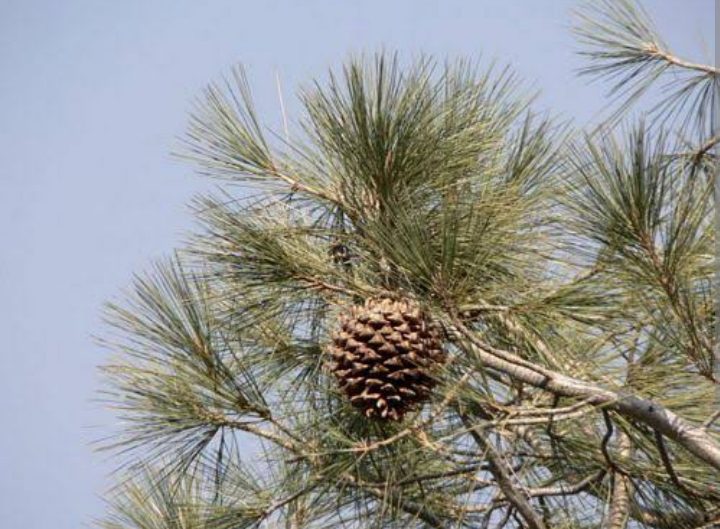
Gray pine is a very drought-tolerant California native that grows equally well in moist and dry soil. It has grey-green needles and a conical shape, and it grows at a rate of about 36 inches per year, reaching a height of 65 feet. Individuals in the wild can reach as high as 120 feet.
This pine does not grow in a conical shape like your typical pine tree. Its branches split and extend out all sorts of ways. It also is the pine which can grow at the lowest elevation. Its cones can grow larger than the size of mangoes, and have curved points coming off the scales of the cone.
California White Alder

Commonly called the California, mountain or white alder (Alnus rhombifolia), this deciduous tree with pale gray bark that seems to peel as it ages, can reach heights of 80 feet in ideal growing conditions. The white alder flowers in the early spring and thrives in open wet areas, such as along streams and river banks.
These trees have good root systems, can withstand flooding and possible periods of constant moisture, provide good wildlife habitat and don’t have the invasive tendencies of many exotic species.
The white alder should not be confused with the European alder (Alnus glutinosa), an invasive tree found in Canada and several central and southern states.
California buckeye
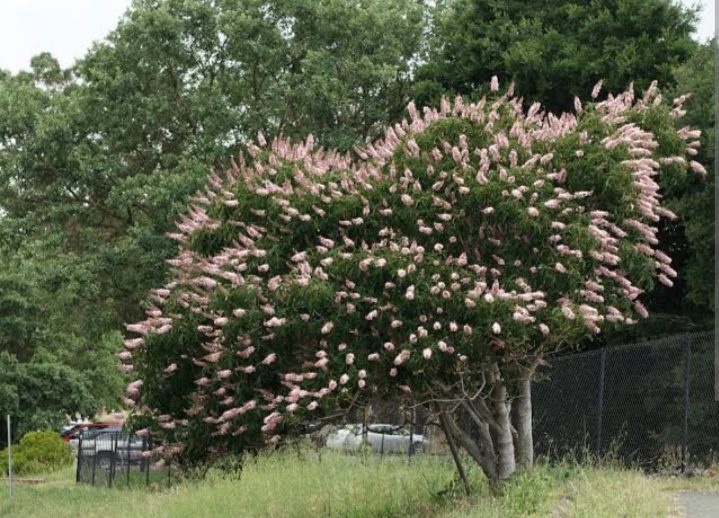
California buckeye the only buckeye native to the West, is found throughout California’s coastal mountains and the foothills of the Sierra Mountains. Buckeyes are also called chestnuts or horse chestnuts. The California buckeye can be grown in a Mediterranean climate with hot dry summers and cool, moist winters.
The deciduous California buckeye grows in a broad, round shape with symmetrical branches. It grows bunches of five to seven leaves that have serrated edges and showy, fragrant, white-to-pale rose flowers in the spring. The flowers yield a pear-shaped fruit containing light brown nuts. The fast-growing California buckeye grows from 15 to 40 feet tall with a spread of 30 to 60 feet.
Weeping willow
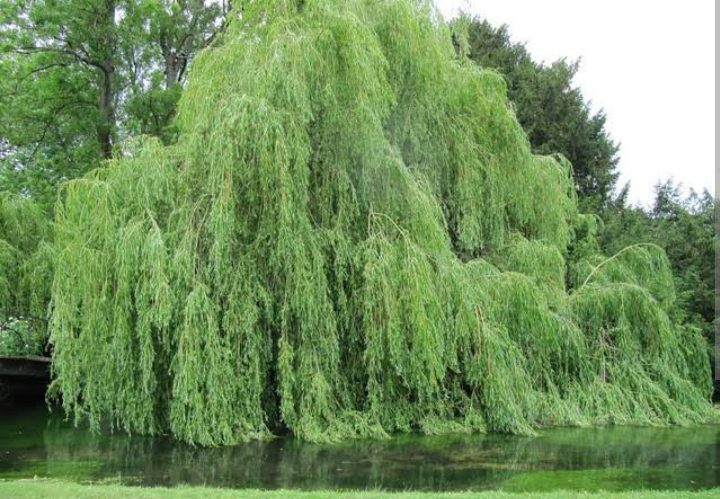
The standard weeping willow (Salix babylonica) features reddish-brown twigs that add winter interest to your landscape after the leaves fall. It grows to 50 feet tall and 20 to 40 feet wide at a rate of 36 inches per growing season.
A deciduous tree, Weeping Willow welcomes long tubular flowers around February just before the arrival of new foliage growth. The flowers are filled with nectar welcoming pollinators and have a blooming season that can last as long as the beginning of summer. With a relatively short life-span, this tree can last up to 30 years.
Also Read: Small And Large Florida Palm Trees
Coast redwood
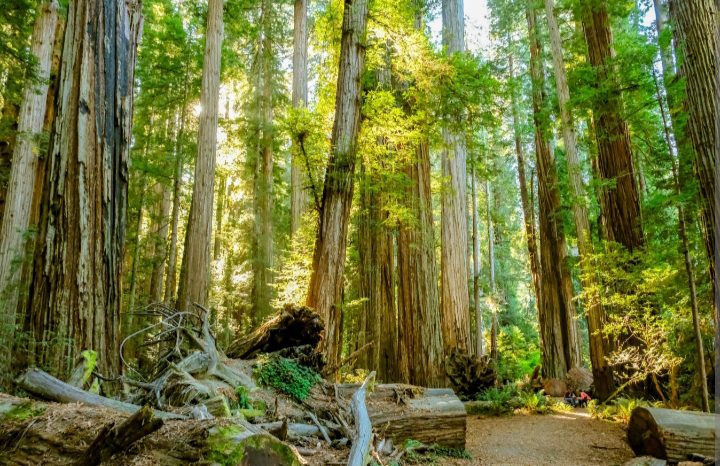
Native to northern coastal California and parts of Oregon, the coast redwood (Sequoia sempervirens) stands among the world’s tallest trees. Individuals typically grow 20 to 35 feet wide over 25 years.
Coast redwood trunks rarely exceed 16 feet in diameter. The foliage is medium to dark green, and the bark is reddish brown and furrowed. In spring, brown cones up to 1.5 inches long follow small brown flowers. Many coast redwood trees are in state parks, where they are protected. The trees reproduce via seeds or sprouts.
Santa Lucia fir

The Santa Lucia fir or bristlecone fir, is the rarest and most endemic fir in North America, and according to some, the world. It is confined to steep-sided slopes and the bottoms of rocky canyons in the Santa Lucia Mountains, in the Big Sur region on the central coast of California, United States.
This tree grows between 66 to 115 feet tall tree and has a slender, spire-like form. The thin bark is reddish-brown with wrinkles, lines and resin vesicles (‘blisters’). The branches are downswept. The needle-like leaves are arranged spirally on the shoot, but twisted at the base to spread either side of the shoot in two moderately forward-pointing ranks with a ‘v’ gap above the shoot.
Vine maple

Vine maple is a deciduous shrub that often has multiple twisted trunks unless growing in full sunlight when it can have a single trunk. The short grayish trunk and tangled greenish branches are often described as being vinelike, hence its common name. It is a tall, erect shrub, growing to about 8 meters or 25 feet and about 20 cm or 8 inches in diameter.
The vine maple is found from SW British Columbia to northern California, most often west of the Cascades. Vine maples are often found in moist soils, along shaded stream banks, and communities adjacent to wetlands where the soils are not saturated for long durations.
River Birch
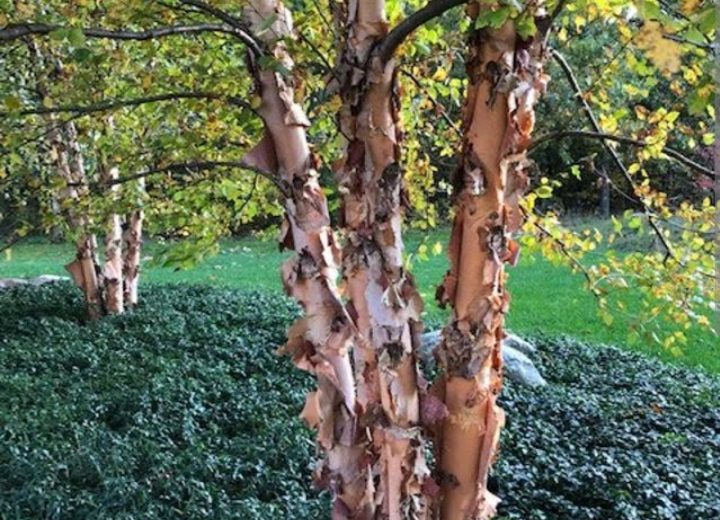
River birch (Betula nigra), also known as red birch, black birch or water birch, is native to the California United States where the trees typically grow in thickets along rivers and lakeshores, as well as on floodplains, sandbars and islands in streams.
River birch is a fast-growing, deciduous semi-aquatic tree that reaches between 50 and 90 feet in height. Its diamond shaped, double-toothed leaves produce an erect or spreading canopy that covers an extensive area. The leaves turn yellow in the fall. When young, its peeling bark is silvery gray, before changing to pink, reddish-brown or black when mature.
Hackberry

Hackberry, Celtis occidentalis, is native to North Dakota and thrives throughout Florida and California. It grows up to 60 feet tall and has a spread of 50 feet. It has simple, alternate leaves that are 2-5 inches long and have an uneven base to each leaf. The bark on Hackberry is described by many as “warty”, which makes it easy to identify any time of the year.
The fruits are small, pea-like and dark purple and they persist into the late winter months, if not snatched up by wildlife. In the fall, the leaves will turn a yellow-green to yellow-brown color for added interest.
Hackberry is commonly found on roadsides and in forested areas. It will make a great shade tree for any acreage or landscape setting. It is a very fast growing tree and its wood is frequently used for boxes, crates, and firewood.
Sargent cypress
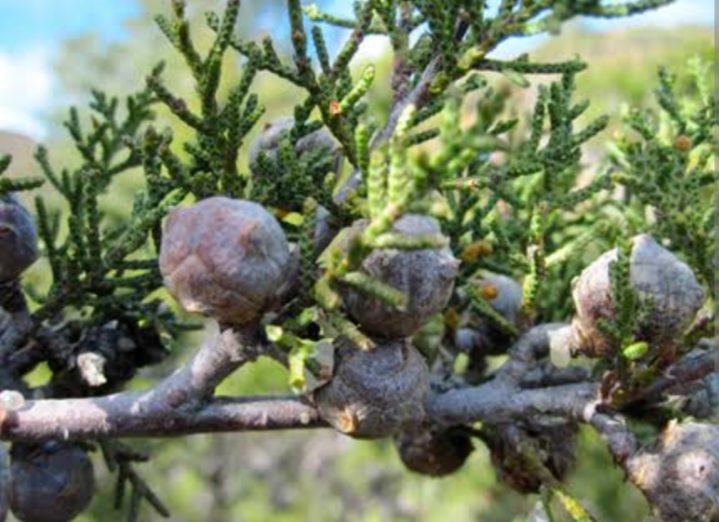
Sargent cypress has the widest natural distribution of any cypress in California—it can be found in the Coast Ranges from Santa Barbara County to Mendocino County. Despite this wide distribution, the species is limited to small, scattered populations due to its affinity for serpentine soils on foggy ridges.
Sargent cypresses are often short and shrubby, but they can also reach heights of up to 90 feet (and three feet in diameter) under ideal soil conditions. The leaves typically don’t have much resin and are not fragrant like many other local conifers. The foliage can be pyramidal or flat-topped, though sometimes it has a rounded appearance.
Like many cypresses native to California, Sargent cypress has a fascinating relationship with fire. Generally, its cones do not open without first being exposed to high heat from a wildfire.
Also Read: Different Types of Japanese Maple Trees
California nutmeg tree

Torreya californica is a species of conifer endemic to California, occurring in the Pacific Coast Ranges and the foothills of the Sierra Nevada. It is commonly known as California torreya or California nutmeg tree. Indigenous peoples used the wood for bows and ate the seeds, which have a lovely nutmeg-like fragrance and appearance.
Growing to a height of 24 metres (about 79 feet) or more, the tree bears spreading, slightly drooping branches. Although pyramidal in shape when young, it may be round-topped in old age. The fissured bark is grayish brown in colour, with orange streaks showing through. The dark-green, rigid, needlelike leaves are nearly flat.
California fan palm

Washingtonia filifera, the desert fan palm, California fan palm, or California palm, is a flowering plant in the palm family Arecaceae, native to the far southwestern United States and Baja California. These palm trees can reach heights up to 80 feet.
Known for its tall, regal appearance and large, rounded, and fan-shaped fronds, the California fan palm is a popular choice for low-maintenance desert landscaping. Each year, their old fan-shaped fronds turn brown and droop, creating a skirt around the thick trunk.
On mature trees, each frond can reach up to 6 feet across. They are deeply toothed and tipped in fibrous threads. Each leaf stalk can reach up to 5 feet in length and is outlined in curved thorns.
Western redbud

Cercis occidentalis, the western redbud or California redbud, is a small tree or shrub found across the American Southwest, from California to Utah and Arizona. It is easily recognized when it is in bloom from March to May, when it is covered with small pink to purple flowers. It naturally grows as a multi-branched shrub that can mature after many years into a small canopy tree.
Western redbud has thin, shiny brown branches that bear shiny heart-shaped leaves which are light green early in the season and darken as they age. Leaves on plants at higher elevation may turn gold or red as the weather cools.